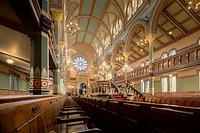Communal efforts are the way to better house of worship security
The most effective approach to securing houses of worship and their members starts with the basics.


About the Author
Robert Graves is the Regional Security Advisor - National Capital Region for Secure Community Network. Through its partnership with the Jewish Federation of Greater Washington, Graves provides security advice, assistance, training and information sharing for the safety of the D.C. area Jewish Community. Graves retired from the FBI in 2017 after a 22-year career, focusing on National Security investigations.
Faith-based institutions need to be welcoming and inclusive with their duty of care to provide a safe space for worship, even with constraints on safety and security budgets.
There is no hate more pernicious or more persistent than the vilification of people based on their ethnicity or faith, particularly when that hatred is used to justify violence. According to the most recent data from the Federal Bureau of Investigation (FBI), approximately one in five bias crimes target persons because of their religion. Although houses of worship represent a relatively low percentage of active threat attacks (approximately four percent of events between 2000–2018, according to the FBI), any invasion of sacred spaces will be among the highest impact events any of us ever experiences.
Last year, after a 22-year career as a Special Agent of the FBI and a brief stint in the private sector, I changed careers to devote my energies full-time to the safety and well-being of the Jewish community, joining Secure Community Network, the official safety and security organization of the Jewish community in the U.S. and Canada. Through its partnership with The Jewish Federation of Greater Washington, I have the opportunity to enhance communal security efforts for the security efforts of the Jewish community in the metropolitan D.C. area, addressing the threats and challenges posed by rising anti-semitism. That work has reinforced my belief that it is communal efforts that provide the best path to better house of worship security.
It is impossible to know with any certainty when and where the next attack on a house of worship will be. As security professionals, we know such an attack will likely come again at some point and that preparedness is key. The best strategy to protect families, communities and institutions is to build within each of these a culture of safety, security and resilience. To this end, I work daily to help synagogues, community centers, day schools and other Jewish organizations in my community to be safer, more secure and better prepared to face threats. I provide advice, education and training, all grounded in the simple truth that it is up to every one of us – individuals, community leaders, parents, teachers, role models – to do all we can to make our community safer.
Faith-based institutions face unique challenges in balancing traditions of being welcoming and inclusive with their duty of care to provide a safe space for worship. Those challenges are exacerbated by constraints on safety and security budgets in a non-profit environment. Security professionals sometimes forget about the budget cycle – even nonprofits have annual budget submission requirements. Formal risk assessments are key to giving institutional leaders a clear picture of what is needed to close any security gaps, understanding their risk appetite, keeping their expectations realistic and allowing them to make well-informed risk management decisions.
In working with faith-based organizations and communities, I apply three fundamental principles of security readiness – maintain situational awareness, harden the facility and prepare to respond to incidents. As with all endeavors, a comprehensive security strategy and plan begins with and succeeds through attention to the fundamentals. It is through the efforts of the members, staff and clergy, working with security professionals, that these principles can be effectively implemented to enhance congregational and institutional safety and security.
Situational Awareness
Safety begins with being alert to the world around us, wherever we may be. The more engaged we are with our environment, the better we can recognize hazards and threats. The more our neighbors know us as people and as a community, the better positioned they are to notice and warn us of danger, and to stand with us against threats. This holds true for houses of worship and their members, staff and clergy as well.
Most institutions look first to security camera systems to meet their situational awareness needs. Few, however, can afford sufficient numbers of high-resolution digital cameras to cover all external and internal areas they need to monitor. Fewer still can afford dedicated staff to monitor those cameras effectively. With limited resources, security cameras should be prioritized to afford staff a quick, safe means of putting eyes on critical places when needed, and for forensic purposes post-incident. Camera placement should be risk-driven, with priority first to regular access points on the perimeter of the property and the buildings themselves. Second priority should be given to other high-risk or high-concern areas, such as playgrounds, which should be identified through a formal threat, vulnerability and risk assessment. Camera systems should be accessible remotely, so that they can be checked from anywhere on or off the property. Areas covered by cameras should also be covered by an intrusion detection system or other sensors to alert staff of a potential threat and to cue them to check the camera feed. While newer camera systems include advanced analytics for threat or hazard detection and alerts embedded in the system, these are typically very expensive and the artificial intelligence algorithms driving them are still evolving. Until the price point for these systems drops and the effectiveness of the analytics rises, houses of worship are better served by proven and robust, albeit less sophisticated, technologies.
Congregations often overlook the most valuable resource available to them for maintaining situational awareness – their own membership. An engaged membership is the single best situational awareness tool any church, mosque, or synagogue can have to detect potential hazards or threats. Regular attendees should engage strangers the same way they greet members they see each week, in accordance with their traditions, with the aim of facilitating their worship experience. If they sense something is amiss, they should know to trust their instincts and who to alert for assistance. The congregation’s cadre of greeters and ushers, whether they are board members or volunteers, should be trained to recognize potential hazards or threats and to respond appropriately. Such training should include identification of behaviors indicating a potential attack, de-escalation techniques for addressing disruptive persons, recognizing and off-setting implicit bias, basic first aid, and most importantly, knowledge of the institution’s emergency response plans and procedures. The aim of that training should not be to make security officers of the greeters and ushers, but to provide them tools to enhance the safety of the congregants and visitors and to enhance the effectiveness of professional safety and security staff.
A third element of situational awareness is developing strong working relationships with local police and other first responders. Sir Robert Peele, founder of the London Metropolitan Police, is famously quoted to have said, “The police are the public and the public are the police.” The police are the component of our society that is engaged with threats and hazards beyond the visual range of the house of worship. An active, collaborative relationship between the house of worship and its local police is essential for the police to effectively communicate any alerts and for the congregation to effectively take action on those warnings. Recent and on-going developments add new complexity to community relations with police, and faith-based organizations are uniquely positioned to contribute to community discussions on policing. That contribution should begin with a frank, in-house discussion about what role the police should play in the institution’s security strategy and plan. Whether it is critical incident response, delivering crime prevention and safety education to the congregants and staff, providing visible armed presence during services and events, or some other role, the institution should invest the time to meet with and get to know the local law enforcement that exists to serve them as members of the community. They should meet the officers who patrol their area, as well as their leadership, and afford the police an opportunity to get to know the congregation and the facility. Congregational leadership should use these meetings to share the institution’s needs, concerns and expectations with local public safety officials. As a key constituency of the larger community, when faith-based organizations engage in these conversations with public safety agencies, they can lead and shape that conversation and can serve as a bridge between law enforcement and the community.
Facility Hardening
Congregations should work to make themselves tougher targets for potential perpetrators of criminal or terroristic acts. This presents perhaps the most overt challenge to a faith-based organization as it seeks to balance safety and security with openness. There is a tendency, both by congregants and security professionals, to think of facility hardening in terms of measures that risk turning houses of worship into fortresses. There are straight-forward measures which can be implemented, that are both effective and relatively unintimidating to visitors. The simple things everyone already does – or should be doing – to protect their families and homes from criminals offer a blueprint for how to protect community facilities.
Just as people check before allowing strangers into their homes, so too should they control entry to their houses of worship. Every facility should have an affirmative system of access control that allows it to lock its doors and to identify visitors before admitting them. An electronically controlled lock on entry gates and doors, tied into the security camera system, is a modest expense that can afford the congregation and staff good control of access to the facility, especially during low occupancy times. It should be augmented by greeters and ushers during services and events, as needed, to accommodate crowds. Houses of worship can welcome the stranger without allowing the wolf into the fold.
An extension of access control is the ability to secure facility doors from the inside. It is no surprise that most religious facilities are designed to be locked from the outside (if at all) when they are secured after services or an event. The attack on a synagogue in Halle, Germany, on Yom Kippur in October 2019, demonstrated the importance of being able to lock doors from the inside. That congregation had secured its newly installed security door at the beginning of services, preventing an armed assailant from entering and attacking those inside. Every facility should be able to lock its doors from the inside, especially in an emergency. Ideally, the locking system should be tied to a panic-alarm, which can be used to alert both those inside the facility and 9-1-1 dispatch of a non-fire emergency at the site.
For enterprise security professionals, it may seem obvious, but the importance of routine facility maintenance cannot be overstated and bears repeating. Keeping doors, windows, fences and gates in good repair is a fundamental measure to ensuring a secure facility. Too often, routine checks and maintenance are deferred, either as an oversight or as a cost-saving measure, until there is an incident. Exterior doors and windows should be checked regularly to ensure they readily latch and are secure from unauthorized entry. Fire doors should be checked to ensure panic bars function as designed. Foliage and undergrowth should be trimmed to ensure good lines of sight for camera systems, to minimize places for bad actors to conceal themselves and to reduce fire hazards. Most police departments have crime prevention officers who can help to identify problem areas and remediations in this area. Having them do a crime prevention survey can be an effective way to build the kinds of relationships described earlier.
The presence of security or facility staff can also serve as a deterrent for criminals or other villains. Routine daily checks of the facility’s exterior and grounds, whether by staff members or congregational volunteers, demonstrates that the facility is not easy prey and will likely deter all but the most committed bad actors. The addition of uniformed safety officers, armed security guards, or law enforcement during special events or services adds another very visible layer to that deterrence.
Incident Response
Preparedness to respond to incidents begins with giving advanced thought and planning to hazards and threats that might be encountered. As part of that planning, there should be a commitment to action. We all know the slogan, “See something, Say something.” Institutional safety, security and emergency response plans should be based on the principle, “see something, do something.” If something seems wrong or out of place, members, staff and clergy should be empowered and encouraged to investigate (if it feels safe to do so). If it does not feel safe, they should be ready to take action by notifying the appropriate person or authority, bearing in mind that the police would rather be called for something that turns out to be nothing, than not be called for something that turns into a tragedy. For each type of emergency in those plans, the decision points for alerting institutional leadership and for alerting public safety agencies should be identified. The policies, protocols and procedures should be well explained to the membership and consistently applied to all, members and guests alike.
The core of incident response is individual and institutional preparedness to act in an emergency. Just as many people are trained to know what to do if someone is choking or having a heart attack, they should also train to know how to respond to a variety of emergency situations. Members of the congregation and staff should be offered, and encouraged to attend, training to enhance their personal, emergency response skills. While the likelihood of encountering an active threat in a house of worship is low, the skills gained through such training are invaluable if active threats are encountered anywhere and translate to preparedness to respond to other types of emergencies. First aid training, including Stop the Bleed training, could be critical in the event of an attack on a house of worship. It is also a valuable life-skill and is more likely to be used in cases of routine accidents. The emergency plans and procedures should be made available to all members and staff, and trained and drilled regularly. Honing these skills can imbue the congregants and institutions with resilience and self-confidence that dissuades opportunistic predators.
Finally, institutions must report suspicious activities, bias incidents and crime to appropriate authorities for follow-up action. While this is obviously the case for acts involving violence or threats of violence, it is equally true for acts of simple vandalism, trespass, or other petty crime. People who have attacked houses of worship and their members did not wake up on the day of their attack with a new idea to create mayhem or death. They were on a pathway to violence that began some time before. As whatever grievance they held took shape, their ideation assigned blame to persons of a particular faith or ethnicity and rationalized violence against them. They planned and prepared for their attack, along the way telegraphing their intent to those closest to them and in many cases to their intended targets through surveillance, harassment, trespass, or vandalism. In isolation, such acts may appear minor or unimportant to the institution. The police, however, will likely be able to place incidents in context and assess any threat they may signal. Law enforcement are better positioned to make a determination if under law an incident is a hate crime, a bias incident or something else. These professionals typically come equipped with specialized skills for identifying, de-escalating and managing hazards and threats that the membership should not be expected to possess or exercise on their own.
A Final Thought
Hate against people and institutions because of their faith is a scourge that has plagued civilization for millennia. As I work daily with the Jewish community of the metropolitan D.C. area in the face of rising anti-semitism, I am evermore certain that the most effective approach to securing houses of worship and their members starts with the basics – maintain situational awareness, harden the facility and prepare to respond to incidents. Nobody can predict or prevent every attack, but by working in collaboration with and supported by security professionals, who understand the breadth and depth of the threats that are out there, houses of worship and their members can be prepared, secure and resilient.
Looking for a reprint of this article?
From high-res PDFs to custom plaques, order your copy today!







